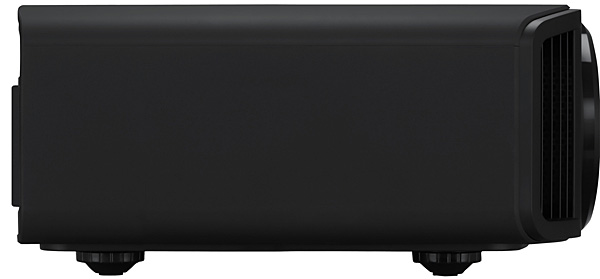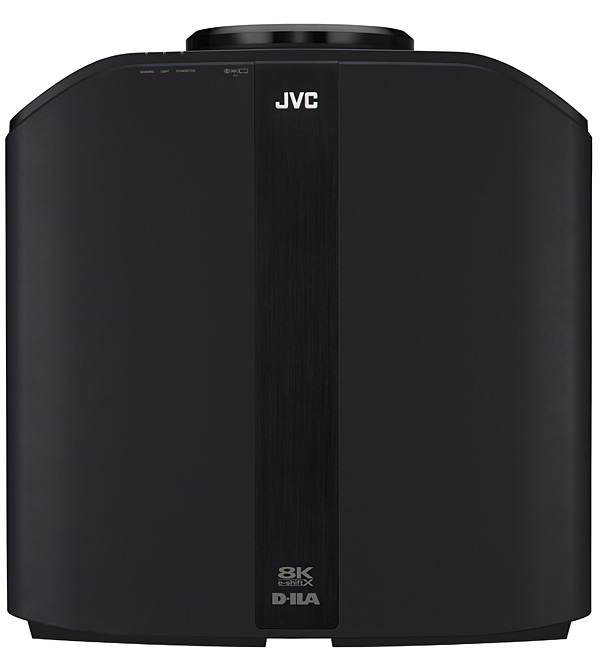JVC DLA-NZ9 8K D-ILA Projector Review Page 2
Native color gamut coverage from the NZ9's laser light engine was similar to what I've measured from other blue laser designs. Rec. 709 (the standard HDTV color gamut) was 100 percent as expected. With the color filter in place, I was able to achieve 98 percent of DCI-P3—similar coverage to the previous NX series. When I measured DCI-P3 coverage (within the BT.2020 container) the NZ9 came up a bit short in its non-filter mode (labelled as BT2020 [Normal] in the color profile menu) at 87 percent coverage. But given the higher light output of this new design compared with the NX series, there is a very appreciable increase in brightness, and it runs quieter in any given picture mode.
 JVC lists the NZ9's contrast ratio as 100,000:1 native (no laser dimming) and infinite with dimming (based on the laser turning off for a full black frame). I did full contrast testing and found that the native contrast at full output with no aperture closure was about 28,000:1 at minimum throw and closer to 50,000:1 at the longest throw (uncalibrated). Maximum native contrast with both apertures fully closed and the projector in its longest throw was about 123,000:1, but even at minimum throw the projector could still deliver close to 100,000:1.
JVC lists the NZ9's contrast ratio as 100,000:1 native (no laser dimming) and infinite with dimming (based on the laser turning off for a full black frame). I did full contrast testing and found that the native contrast at full output with no aperture closure was about 28,000:1 at minimum throw and closer to 50,000:1 at the longest throw (uncalibrated). Maximum native contrast with both apertures fully closed and the projector in its longest throw was about 123,000:1, but even at minimum throw the projector could still deliver close to 100,000:1.
With laser dimming engaged, contrast increased substantially with Mode 1 reaching close to 470,000:1 and Mode 2 hitting around 560,000:1. Mode 2 on the RS4500 would go to full black-out when displaying a full black field, but the NZ9 does not. (This may be addressed in future firmware, though I didn't get confirmation of that from JVC.) Blackouts still looked very dark and anyone would be easily tricked into thinking the projector was displaying a full black. The NZ9's laser dimming also didn't display the RS4500's aggressive tendency to black-out images that should be visible during very dark scenes. This was probably my biggest gripe with the RS4500's laser dimming and it has definitely improved in this new implementation.
That's not to say the JVC's laser dimming is perfect. Any dynamic modulation system on a projector will always have issues with gamma modulation and clipping, and I found the NZ9 to be a bit too aggressive in dimming low- to mid-bright image highlights. The dimming would improve black levels at times, but there were also quite a few instances where highlights and brighter objects were affected though the black floor didn't share the same benefit. This would result in slight changes to color balance, mild highlight clipping, and a muting of detail in bright objects, and it also decreased my subjective perception of contrast.
The good news here is that, with the NZ9's already high native contrast, laser dimming isn't needed for the most part. The feature did seem to work better with HDR images than SDR ones, which means it may benefit from the frame analysis that JVC uses for tone mapping. I could see most viewers happily using it, but I can be a bit too picky and was content to leave it off. Ultimately, what I would really like to see JVC implement is a third dimming mode offering the ability to turn the laser off with a full blackout. Seeing a dramatic full black was the only thing I really missed with laser dimming turned off, so it would be great to have a mode that only impacted that situation.
Another new feature JVC announced for both this model and the DLA-NZ8 is an optimized high contrast light engine designed to eliminate uniformity issues caused by reflections within the light path or optics. The new engine effectively addressed this during my testing: nearly all image streaking was reduced, with only a tiny amount visible when a bright object appeared on a full black background. It also dramatically improved the mixed contrast measurements (listed in the Test Bench section) compared with earlier JVC models. DLP-based projectors typically score well on such measurements, which reveal contrast as the average picture level of an image is increased, but not LCOS designs like the JVC. But in my testing the NZ9 more than doubled its contrast performance compared with the previous NX9, and it was more in line with what I see from higher-end DLP models.
JVC's new features added up to a modest but welcome improvement in image quality compared with what I'm used to getting with my NX9. There was additional light to play with in High Laser mode, and I could also get a bit better light output in Mid Laser mode while benefitting from dramatically quieter operation. Of all the new features, the most controversial might be 8K eShiftX, a mode I was curious to test as I didn't really note any visual improvement with the previous 8K eShift implementation in my NX9.

Given the current dearth of 8K content, I had no real way to test the new e-ShiftX system, so I reached out to test equipment manufacturer Murideo to borrow an 8K signal generator. The company loaned me its SIX-G 8K generator so I could put e-ShiftX to the test with full 8K-quality test patterns. The NZ9 breezed through the test patterns with crisp, clear representation and no discernable scaling or processing artifacts—a positive sign for the day when we might see consumer 8K content (likely a long time from now). But the real question remains: Does 8K offer any current benefit for home theater systems?
The answer is yes—and no. From a strict resolution standpoint, I find 4K to be more than enough for even the largest home theater screens (and to be honest, movie theater screens as well). Individual pixels in full 4K-resolution static test patterns are non-discernable at most seating distances. And when you add in the fact that the 4K movies and TV shows we watch on disc or via streaming fall short of the full resolution of a static 4K pattern due to losses from motion and video compression, it becomes clear that 8K doesn't seem necessary.
Where I do see the benefit is when any type of image processing such as scaling and enhancement is being applied. With 8K, these extra processes extend over far more pixels and as a result lack the immediate artifacts you may see at lower resolutions, 4K included. Viewing in 8K also helped with motion resolution. The image took on a quality that reminded me of frame interpolation, but without any of the annoying "soap opera effect" on camera motion and pans. I also noted a subtle increase in apparent depth, dimension, and detail on lots of material I regularly use for testing. So, while I was quite the skeptic about viewing standard HD and 4K content on an 8K display going into this review, the more I watched the more I liked it.
To cite two examples, EShiftX yielded an appreciable increase in image clarity on the Ultra HD Blu-ray of Blade Runner 2049 and the 4K/HDR image montage on the Spears & Munsil UHD HDR Benchmark disc. Other scenes I've used repeatedly for demos and testing showed marked improvement. The difference wasn't night and day, but it was visible.
I wanted to have an opportunity to test the NZ9's 4K/120Hz input with a next-gen gaming console from Microsoft or Sony but was unable to obtain one. (These seem to be really hard to get at the moment.) I was also hoping to test latency with a 4K/120Hz signal (for gaming), but the Murideo generator doesn't support latency testing at that resolution.
I spent a lot of time with the NZ9, viewing a wide variety of HD and Ultra HD content from sources including my Oppo 4K Blu-ray player, Kaleidescape Strato system, and Apple TV 4K streamer. Overall performance was a definite uptick from my NX9, though the difference wasn't drastic. The laser light engine provided a lot more headroom for HDR than the previous NX9 and subtle improvements in the Theater Optimizer setup further improved HDR performance. JVC's new Auto Frame Adapt HDR mode did a fantastic job of balancing the settings to use for overall brightness across different HDR sources, making it a true set-and-forget solution compared with the previous line.

When watching a variety of difficult test material I've collected for HDR testing, the JVC's Auto mode always ended up using the amount of range I would have personally selected if I was making manual adjustments across the five available Frame Adapt HDR presets (-1 thru +2). I am used to viewing 4K/HDR via an outboard video processor in my setup (Lumagen Radiance Pro). While the Radiance Pro had the upper hand during some of my most extreme testing (very dark movies like Black Panther, or very bright ones like The Meg), the JVC did a better job handling some of the HDR tone mapping (specifically, some of the necessary desaturation) on the Spears & Munsil montage and even some scenes in The Meg. JVC remains miles ahead of its competition in the projector space when it comes to onboard HDR support, and this new model pushes the envelope even further. I can't imagine most people having issues with its HDR presentation, and the new Auto mode makes things completely set and forget.
Conclusion
Wrapping up, the big question for me is: Are JVC's new projectors a worthwhile upgrade if you already own one of the previous NX series models? The new DLA-NZ9 without a doubt delivers a better-looking image than my DLA-NX9, and I already thought the NX9 was one of the best projectors at any price point. Again, the difference wasn't night and day, but there were appreciable differences when it came to image definition, contrast, and depth. The NZ9 also offers higher light output, quieter operation, and support for true 8K (not to mention 4K/120Hz for gaming) should that ever become a consumer option. And I know that the projector's laser light engine will outlast a bulb by a considerable amount, so as a long-term projector it easily makes the case for itself.
Ultimately, one must weigh modest improvements in image quality against a substantial increase in features. I don't think anyone upgrading will regret the decision, and I've already decided to take the jump myself by replacing my own NX9 with the new NZ9. I can't think of a better recommendation than that. If JVC's NZ9 provides the light output you need for your screen size, I can't think of a projector that offers better overall picture quality at anywhere near its $25K price point.
Note: The Where to Buy link below is an affiliate link. If you purchase through the link, we may earn a small commission at no extra cost to you. Thank you for your support!























































